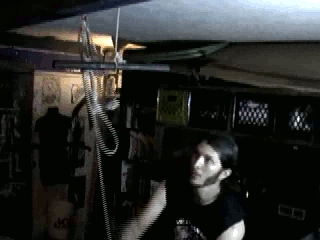
Rope Pulley And Prusik Knot Kick Stretching Trainer
This kick stretching trainer tool was adapted based on my experience with prusik knots in my forest defense days. I learned a lot of knots in the forest defense campaigns for tree climbing and tree-sitting. The prusik knot is really quite an ingenious innovation in terms of rope climbing. It allows you to use a gravitation load to tighten the knot such that when that load is lifted or released, the knot can be easily loosened by hand. To describe it, you start with a loop, or a rope that's ends are tied to each other such that it becomes a secure circle or loop. You then take that loop, wrap it several times around another rope, then pull one end of the loop down and out through one of the lower wrapped loops. It's much better understood visually but the concept is basically that whatever load you put on the end of the loop hanging down below the wrapped loops works to constrict the wrapped loops around the center rope so that it can be stabilized at that point on the rope. We called it shimmying up the rope. One prusik would be put above another with the top prusik securing a climbing harness and the bottom having an attached foot loop of webbing material. This system allowed us to start by putting the load of our body in the climbing harness on the top prusik, then we'd put a foot in the lower prusik foot loop, stand up in it thus transferring the load from upper to lower prusik, at which point, the upper prusik could be loosened by hand and slid up the vertical rope. By repeating this process we could climb ropes all the way up into the upper canopy of old growth forest trees over 100 feet up. Our lives were secured by this clever knot and I'll never forget it.
So years later at the peak of my Jeet Kune Do martial arts/self-defense studies and training I thought to apply this knot to practice of gradually increasing the height of my legs while stretching. Using a pulley to make it possible to use arm strength to pull a rope upwards, and using a foot loop on the other end to hoist my leg up, I could draw my leg upward and use a prusik knot on the rope to allow my leg to rest a certain point, then relax, breathe, and slowly inch along by incrementally repeating the process and sliding the prusik know up the rope. It worked well to help me get my high kicks back after it had been years since I was able to do the splits. It was much easier to achieve leg flexibility at a younger age, but with careful use of tools like this, I've been able to salvage some of what came much easier earlier in life.
I don't teach or train excessively with high kicks, as they would rarely be realistic in street fighting, however, you never know what angle or height you'll be at, and if it's possible to get a fuller range of motion with any potential fighting weapon, there's no excuse not to train. As Bruce Lee taught, if you're taking about combat...you better train every part of your body.